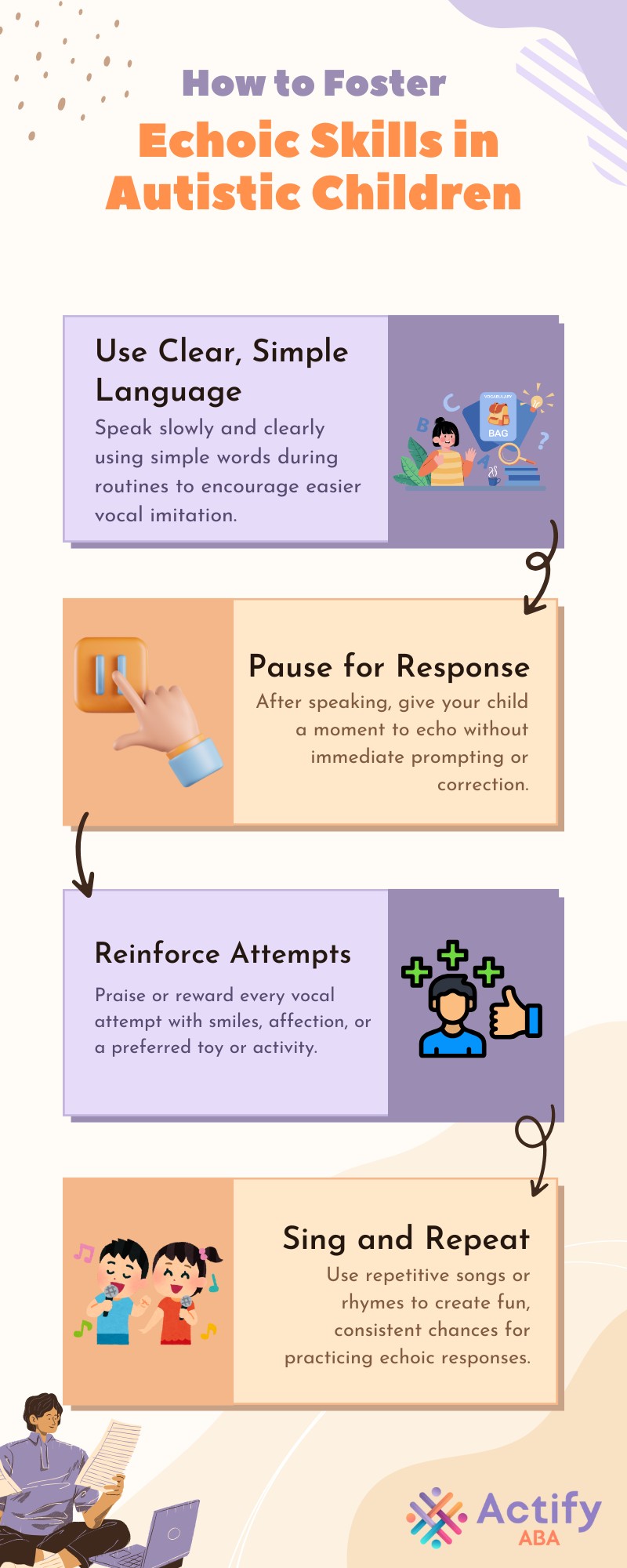
Key Points:
- Echoic behavior examples include repeating words or sounds immediately after another person speaks.
- Echoic responses are foundational verbal operants in ABA, supporting language development and communication.
- Identifying, prompting, and reinforcing echoic skills helps build complex speech and social interaction abilities.
Speech and communication challenges are common in autism, with up to 30% of children with autism remaining minimally verbal, according to research. Early interventions that focus on foundational language skills—like echoic behavior—can make a profound difference in long-term outcomes.
Echoic behavior in ABA therapy involves a child repeating words or sounds immediately after hearing them, and it plays a vital role in developing vocal imitation and verbal communication. In this article, we’ll explore real-life echoic ABA examples, teaching techniques, and strategies that help children move from repetition to meaningful speech.
What is Echoic Behavior?
Echoic behavior occurs when a child hears a sound, word, or phrase and repeats it exactly, immediately reinforcing their ability to mimic speech. In ABA, echoic behavior is a type of verbal operant that helps children develop oral language.
For example, a therapist says “ma-ma,” and the child echoes “ma-ma.” This back-and-forth is more than mimicry—it’s a measurable step that builds vocabulary, articulation, and verbal fluency.
Why are Echoic Responses Important in ABA?
Echoic behavior is a cornerstone in language development. It teaches imitation of speech sounds, which then leads to independent verbal behavior.
First, the child learns to respond vocally to a model. Once this is established, they move into other verbal operants like manding (requesting) and tacting (labeling). Echoic skills support pronunciation, increase verbal repertoire, and reinforce that speech can influence others—a powerful motivator in itself.
How Do Therapists Teach Echoic Behavior?
Teaching echoic behavior is structured and data-driven. Clear prompts, models, and reinforcement strategies guide learners through vocal imitation. Before introducing echoing, the therapist identifies sounds or words within the child’s current ability.
Then, they use clear, consistent prompting and model the target sound multiple times. Reinforcement follows immediately—either with praise, a token, or a preferred item. This cycle ensures each echoic attempt is recognized and rewarded, reinforcing the sound-word association until it becomes natural.
What are Common Echoic Behavior Examples?
Echoic behavior develops in stages, beginning with simple sound imitation and gradually advancing to full sentence repetition with accurate pronunciation. Echoic responses progress from simple to complex.
Examples include:
- Syllable Imitation: Repeating basic sounds like “ba,” “da,” “ma.”
- Single Word Echoes: Imitating words such as “ball,” “cat,” and “open.”
- Short Phrases: Echoing simple phrases like “thank you” or “I want juice.”
- Sentence-Length Echoes: Repeating longer phrases like “I want to play with you.”
- Imitation with Phonetic Accuracy: Focusing on correct pronunciation and consistent echoing over time.
As each level is mastered, therapists adjust expectations and prompt natural spontaneous speech.
How is Echoic Behavior Reinforced?
Reinforcement is essential for developing echoic behavior in ABA therapy. When a child successfully imitates a word or sound, therapists immediately provide a preferred reinforcer—this could be enthusiastic praise (“Great job saying ‘ball’!”), access to a favorite toy, or a token that leads to a larger reward.
This direct connection between the vocal imitation and a positive outcome helps the child associate speech with success and satisfaction. Therapists may also use techniques like echoic chaining, where the echoed word becomes part of a functional communication exchange—for example, repeating “cookie” to then receive a cookie.
These reinforcement strategies not only encourage repetition but also help transition echoic behavior into meaningful language. By consistently reinforcing attempts, even approximations, ABA therapists build the child’s confidence and strengthen their overall communication abilities.
How Can Parents Help Foster Echoic Skills?
Parents play a crucial role in supporting their child’s echoic development outside of therapy sessions. By using simple strategies, caregivers can turn everyday routines into powerful learning opportunities that build speech, confidence, and early communication skills.
At home, they can:

These strategies create natural learning opportunities outside the therapy setting.
When Does Echoic Behavior Transition to Functional Language?
Echoic behavior transitions to functional language when a child begins using words spontaneously to request, label, or engage in conversation. This shift occurs after consistent reinforcement, modeling, and generalization of echoed words into meaningful, independent communication.
Therapists guide this transition by expanding echoic responses into other verbal operants—like mands (requests), tacts (labels), and intraverbals (conversational responses). As echoing becomes more accurate and consistent, children learn that words have power and purpose, leading to more natural and intentional language use across settings.
What Challenges Arise in Teaching Echoic Behavior?
Teaching echoic behavior can be challenging due to differences in each child’s speech, attention, and motivation. Some children may struggle with sound discrimination, articulation, or may not find vocal imitation reinforcing at first.
Other challenges include prompt dependency, where a child only echoes when prompted, or difficulty generalizing echoic skills to new settings or people. Therapists address these by using varied prompts, visual aids, and reinforcing even approximations. Ongoing data tracking and collaboration with parents are essential for overcoming barriers and building spontaneous, functional speech.
How is Echoic Behavior Measured?
Tracking echoic behavior in ABA involves observing multiple dimensions to assess progress accurately. Therapists collect consistent data on response quality, timing, and independence to adjust teaching strategies and guide the next steps in communication goals.
Here’s how echoic behavior is measured:
1. Accuracy of Echo
Therapists track whether the child repeats the word or sound exactly or with approximations. Measuring how closely the child’s echo matches the model helps determine progress in articulation and sound imitation.
2. Latency of Response
Latency refers to the time between the model and the child’s echo. Shorter latencies indicate stronger stimulus control and more fluent echoic responding, showing readiness for more advanced communication goals.
3. Level of Independence
Observers note whether the child needs a prompt to echo or responds independently. Increased independence over time signals growth in spontaneous vocal imitation and reduced reliance on adult cues.
4. Generalization Across Settings
Therapists assess whether the child can echo with different people, in new environments, or during various routines. Generalization shows the child is using echoic skills functionally, not just during structured sessions.
5. Consistency Over Time
Reliable performance across days and sessions shows true mastery. Therapists look for consistent echoic behavior before advancing to more complex verbal operants like mands, tacts, and intraverbals.

How Does Echoic Behavior Support Overall Communication?
Echoic behavior plays a foundational role in developing expressive language. By strengthening speech imitation, children build the skills needed for requesting, labeling, and engaging in meaningful social interactions—key components of successful communication across settings.
Here’s how echoic behavior helps support overall communication skills:
1. Builds Vocabulary Foundation
Echoing helps children acquire new words, increasing their vocabulary and making it easier to express wants and needs.
2. Improves Speech Clarity
Practicing accurate repetition of sounds and words enhances articulation, making the child’s speech more understandable to others.
3. Supports Conversational Skills
Echoic behavior teaches turn-taking in speech and sets the groundwork for more interactive, back-and-forth conversations.
4. Boosts Confidence in Speaking
Frequent opportunities for successful echoing encourage children to use their voice more often and with greater ease.
5. Leads to Independent Verbal Behavior
Mastery of echoic skills supports progression to functional language use, such as making requests and sharing ideas without prompts.
Take the Next Step Toward Progress With ABA Therapy
Echoic behavior examples are more than repetition—they’re the roots of expressive language. By guiding children through echoing sounds, words, and phrases, ABA lays the groundwork for meaningful communication.
At Actify, we offer caring, evidence-based ABA therapy in Maryland, focused on growth across verbal operants—from echoic imitation to mands and tacts. Our team works closely with families, using clear strategies and data-driven methods to support each child’s speech development.
Contact us today to learn how ABA therapy in Maryland can help your child build powerful verbal skills.
